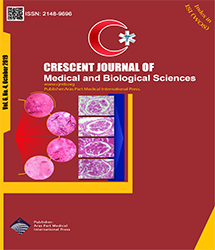| Original Article | |
| Comparative Outcome of Different Types of Redo Surgery in Malfunction of Mechanical Prosthetic Mitral Valve | |
| Babak Nasiri1, Naser Khezerlou Aghdam1, Rezayat Parvizi1, Mohamadreza Taban Sadeghi1, Sanaz Mousavi2, Nasrin Khaki1 | |
| 1Cardiovascular Research Center, Tabriz University of Medical Sciences, Tabriz, Iran 2Gynecology Research Center, Tabriz University of Medical Sciences, Tabriz, Iran |
|
|
CJMB 2019; 6: 529–534 Viewed : 3625 times Downloaded : 2709 times. Keywords : Cardiac valve prosthesis, Heart valve prosthesis implantation, Bioprostheses |
|
| Full Text(PDF) | Related Articles | |
| Abstract | |
Objectives: Redo mitral valve replacement (MVR) is an important therapeutic approach in patients with the malfunction of the prosthetic mitral valve, especially in patients with severe dyspnea or a large thrombus burden. Redo replacement (MVR) and thrombectomy are different surgical approaches in these patients. This study evaluated the outcome of the second Materials and Methods: To this end, 71 patients were included in this study, who underwent second mitral valve surgery following the malfunction of the prosthetic mitral valve in the last 10 years. These patients were divided into M-MVR, B-MVR, and surgical thrombectomy groups and their demographic, clinical, echocardiographic, and laboratory findings were gathered as well. Then, the patients were evaluated for their third MV surgery if it was performed, followed by evaluating the pump time and cross-clamp time. Results: Fifty-seven, 8, and 6 patients underwent M-MVR, B-MVR, and thrombectomy, respectively. Based on the results, the mortality rate was not signifcantly different between the 3 groups (P=0.059). In addition, 12 patients underwent the third surgery with the highest (100%) and lowest (0%) rates at thrombectomy and B-MVR groups, respectively. Higher pump time and cross-clamp time were signifcantly associated with an increased mortality rate (P=0.014 and P=0.026, respectively). Conclusions: In the malfunction of the prosthetic mitral valve, mortality rate failed to signifcantly differ between the patients undergoing M-MVR, B-MVR, and thrombectomy but third surgery is often needed after thrombectomy. It seems that the replacement of previous prosthetic valve with a new mechanical or biological valve yields better results in the case of prosthetic valve malfunction. |
Cite By, Google Scholar
Google Scholar
PubMed
Online Submission System
 CJMB ENDNOTE ® Style
CJMB ENDNOTE ® Style
 Tutorials
Tutorials
 Publication Charge
Medical and Biological Research Center
About Journal
Publication Charge
Medical and Biological Research Center
About Journal
Aras Part Medical International Press Editor-in-Chief
Arash Khaki
Deputy Editor
Zafer Akan


















